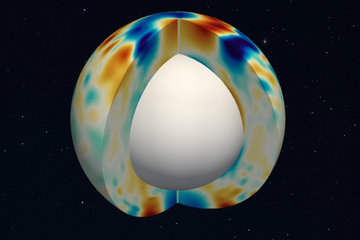All genres
21.
Journal Article
A comparison between solar plage and network properties. Astronomy and Astrophysics 630, A86 (2019)
22.
Journal Article
Recent advancements in the EST project. Advances in Space Research 63 (4), pp. 1389 - 1395 (2019)
23.
Journal Article
Superstrong photospheric magnetic fields in sunspot penumbrae. Astron. Astrophys.; EDP Sciences, Les Ulis Cedex A France 631, A99 (2019)
24.
Journal Article
Measuring the Wilson depression of sunspots using the divergence-free condition of the magnetic field vector. Astronomy and Astrophysics 619, A42 (2018)
25.
Journal Article
Spectropolarimetric NLTE inversion code SNAPI. Astronomy and Astrophysics 617, A24 (2018)
26.
Journal Article
Image restoration of solar spectra. Astronomy and Astrophysics 608, A76 (2018)
27.
Journal Article
A Tale of Two Emergences: SUNRISE II Observations of Emergence Sites in a Solar Active Region. Astrophysical Journal, Suppl. Ser. 229 (1), 3 (2017)
28.
Journal Article
Solar Coronal Loops Associated with Small-scale Mixed Polarity Surface Magnetic Fields. Astrophysical Journal, Suppl. Ser. 229, 4 (2017)
29.
Journal Article
Photospheric Response to an Ellerman Bomb-like Event-An Analogy of SUNRISE/IMaX Observations and MHD Simulations. Astrophysical Journal, Suppl. Ser. 229 (1), 5 (2017)
30.
Journal Article
Oscillations on Width and Intensity of Slender Ca ii H Fibrils from Sunrise/SuFI. Astrophysical Journal, Suppl. Ser. 229, 7 (2017)
31.
Journal Article
Morphological Properties of Slender Ca II H Fibrils Observed by Sunrise II. Astrophysical Journal, Suppl. Ser. 229, 6 (2017)
32.
Journal Article
Erratum: Morphological Properties of Slender Ca II H Fibrils Observed by SUNRISE II (vol 229, 6, 2017). Astrophysical Journal, Suppl. Ser. 230 (1), 11 (2017)
33.
Journal Article
The Maximum Entropy Limit of Small-scale Magnetic Field Fluctuations in the Quiet Sun. The Astrophysical Journal Supplement Series 233, 5 (2017)
34.
Journal Article
Slender Ca II H Fibrils Mapping Magnetic Fields in the Low Solar Chromosphere. Astrophysical Journal, Suppl. Ser. 229, 11 (2017)
35.
Journal Article
Kinematics of Magnetic Bright Features in the Solar Photosphere. Astrophysical Journal, Suppl. Ser. 229 (1), 8 (2017)
36.
Journal Article
Transverse Oscillations in Slender Ca II H Fibrils Observed with SUNRISE/SuFI. Astrophysical Journal, Suppl. Ser. 229 (1), 9 (2017)
37.
Journal Article
Moving Magnetic Features Around a Pore. Astrophysical Journal, Suppl. Ser. 229 (1), 13 (2017)
38.
Journal Article
Line response functions in nonlocal thermodynamic equilibrium. Isotropic case. Astronomy and Astrophysics 601, A100 (2017)
39.
Journal Article
Spectropolarimetric Evidence for a Siphon Flow along an Emerging Magnetic Flux Tube. Astrophysical Journal, Suppl. Ser. 229 (1), 15 (2017)
40.
Journal Article
A new MHD-assisted Stokes inversion technique. Astrophysical Journal, Suppl. Ser. 229, 16 (2017)











